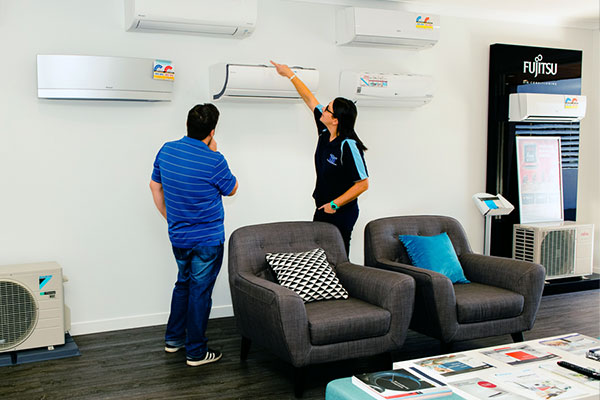Introduction
Air conditioning systems have become an essential part of modern living, providing much-needed relief from the heat and ensuring comfort in our homes and workplaces. With advancements in technology, there are now various types of air conditioning systems available, each designed to meet specific needs and preferences. This comprehensive guide aims to provide an in-depth understanding of the different types of air conditioning systems, their workings, pros and cons, energy efficiency considerations, and tips for choosing the right system for your home.
Types of Air Conditioning Systems
Central Air Conditioning Systems
Central air conditioning systems are the most common type of cooling system used in homes and commercial buildings. These systems utilize a network of ducts to distribute cool air throughout the entire building.
- How it Works: Central AC systems consist of an outdoor unit that houses the compressor and condenser, and an indoor unit that contains the evaporator coil and air handler. The refrigerant cycles between these units, absorbing heat from indoor air and releasing it outside.
- Pros:
- Efficient cooling for entire buildings.
- Quiet operation, as the noisy components are located outside.
- Better air quality through integrated filtration systems.
- Cons:
- Higher installation costs due to ductwork.
- Duct leaks can reduce efficiency.
- Less control over individual room temperatures.
Ductless Mini-Split Systems
Ductless mini-split systems are ideal for homes without existing ductwork or for adding cooling to specific areas.
- How it Works: These systems consist of an outdoor compressor unit and one or more indoor air handling units. Each indoor unit is connected to the outdoor unit via a conduit that houses the refrigerant line, power cable, and drain line.
- Pros:
- Flexible installation options, with no need for ductwork.
- Independent control of temperature in different zones.
- Energy-efficient operation.
- Cons:
- Higher upfront cost compared to window units.
- Indoor units may be visible and affect room aesthetics.
- Regular maintenance required for multiple indoor units.
Window Air Conditioners
Window air conditioners are a popular choice for cooling individual rooms and are typically installed in a window or a specially designed opening in a wall.
- How it Works: These units are self-contained and include all the necessary components within a single housing. They draw warm air from the room, cool it using a refrigerant, and then circulate the cooled air back into the room.
- Pros:
- Affordable and easy to install.
- Compact design, suitable for small spaces.
- Efficient for cooling single rooms.
- Cons:
- Limited to cooling one room at a time.
- May obstruct the window view.
- Can be noisy compared to other systems.
Portable Air Conditioners
Portable air conditioners offer flexibility and convenience, allowing users to move the unit from room to room as needed.
- How it Works: Similar to window units, portable air conditioners contain all components within a single unit. They use a hose to vent hot air outside through a window or an opening in a wall.
- Pros:
- Easy to move and install.
- No permanent installation required.
- Suitable for spaces where window units are not feasible.
- Cons:
- Less efficient compared to window units.
- Takes up floor space.
- Can be noisy and require frequent water drainage.
Hybrid Air Conditioners
Hybrid air conditioners combine the features of central air conditioning with other cooling methods, such as heat pumps or geothermal systems.
- How it Works: These systems can switch between electricity and fossil fuels to power the system, optimizing energy use based on the outside temperature.
- Pros:
- Highly energy-efficient.
- Can provide both heating and cooling.
- Reduces carbon footprint by using renewable energy sources.
- Cons:
- High initial installation costs.
- Requires professional installation and maintenance.
- May not be suitable for all climates.
Geothermal Air Conditioning Systems
Geothermal air conditioning systems utilize the stable temperature of the earth to provide efficient cooling and heating.
- How it Works: These systems use a series of underground pipes (loop system) filled with a water-refrigerant mixture. The mixture absorbs heat from the indoor air and releases it into the ground.
- Pros:
- Extremely energy-efficient and environmentally friendly.
- Long lifespan with low operating costs.
- Provides consistent indoor temperatures.
- Cons:
- High installation costs due to the need for extensive digging.
- Requires adequate yard space for the loop system.
- Installation can be disruptive to landscaping.
Energy Efficiency Considerations
Energy efficiency is a crucial factor when choosing an air conditioning system, as it directly impacts both the environment and your utility bills. Here are some key points to consider:
SEER Ratings
The Seasonal Energy Efficiency Ratio (SEER) measures the efficiency of air conditioning systems. A higher SEER rating indicates a more efficient system.
- Understanding SEER: SEER is calculated by dividing the total cooling output over a typical cooling season by the total energy consumed. For example, a system with a SEER rating of 16 is more efficient than one with a rating of 13.
- Minimum Standards: The U.S. Department of Energy sets minimum SEER requirements, which vary by region. As of 2023, the minimum SEER rating for central air conditioners is 14 in northern states and 15 in southern states.
Energy Star Certification
Energy Star-certified air conditioners meet strict energy efficiency guidelines set by the U.S. Environmental Protection Agency.
- Benefits:
- Reduced energy consumption and lower utility bills.
- Environmental benefits through reduced greenhouse gas emissions.
- Often qualify for rebates and incentives.
Variable Speed Compressors
Air conditioners with variable speed compressors can adjust their cooling output to match the current cooling demand, leading to significant energy savings.
- Advantages:
- Improved comfort with consistent indoor temperatures.
- Lower energy consumption compared to single-speed compressors.
- Quieter operation.
Smart Thermostats
Smart thermostats can optimize the performance of your air conditioning system by learning your schedule and adjusting settings automatically.
- Features:
- Remote control via smartphone apps.
- Energy usage reports and tips for saving energy.
- Integration with other smart home devices.
Tips for Choosing the Right Air Conditioning System
Selecting the right air conditioning Denver for your home involves considering several factors to ensure optimal performance and efficiency.
Assess Your Cooling Needs
- Size of the Space: Measure the square footage of the area you need to cool. Larger spaces may require central air conditioning or multiple units, while smaller areas might be adequately served by a window or portable unit.
- Climate: Consider the typical climate in your region. For example, homes in hotter climates may benefit from systems with higher SEER ratings to handle prolonged cooling demands.
- Insulation: Well-insulated homes retain cool air more effectively, reducing the load on your air conditioning system.
Consider Your Budget
- Initial Costs: Factor in the upfront cost of the system and installation. While high-efficiency systems may have higher initial costs, they often result in lower operating expenses over time.
- Operating Costs: Evaluate the long-term energy costs associated with each type of system. High-efficiency units typically offer lower monthly energy bills.
Evaluate Installation Requirements
- Ductwork: Determine if your home has existing ductwork or if new ducts need to be installed. Ductless systems can be a cost-effective solution for homes without ducts.
- Space for Outdoor Units: Ensure you have adequate space for the outdoor components of the system, especially for central and mini-split systems.
- Electrical Requirements: Check that your home’s electrical system can support the new air conditioning unit. Some systems may require electrical upgrades.
Look for Additional Features
- Air Quality Control: Consider systems with advanced filtration options to improve indoor air quality, particularly important for households with allergies or respiratory issues.
- Dehumidification: Some air conditioning units offer dehumidification functions, which can be beneficial in humid climates.
- Noise Levels: Check the noise ratings of different units, especially if you’re sensitive to noise or the unit will be installed in a quiet area like a bedroom.
Consult a Professional
- Expert Advice: HVAC professionals can assess your specific needs and recommend the most suitable system for your home.
- Proper Sizing: Ensuring the correct size and capacity of the air conditioning unit is crucial for efficient operation and longevity.
- Quality Installation: Professional installation helps avoid common issues such as improper refrigerant levels and inadequate airflow, which can impact performance and efficiency.
Conclusion
Choosing the right air conditioning system involves a careful consideration of your specific cooling needs, budget, and installation requirements. By understanding the different types of air conditioning systems, their pros and cons, and energy efficiency ratings, you can make an informed decision that ensures comfort, efficiency, and cost savings for years to come. Whether you opt for a central air conditioning system for whole-house cooling, a ductless mini-split for zoned control, or a portable unit for flexibility, the right system can significantly enhance your indoor environment.



